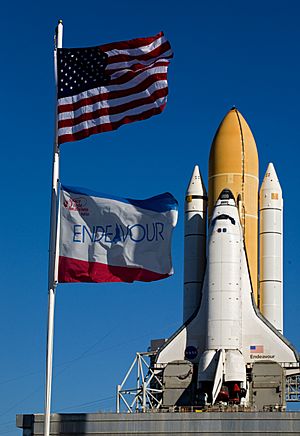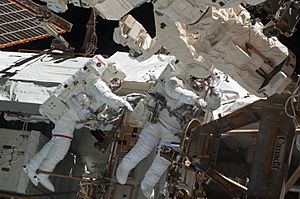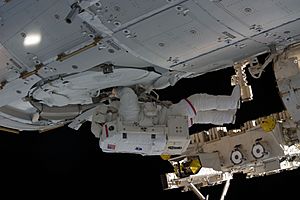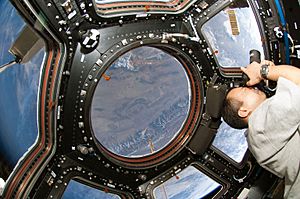STS-130 facts for kids
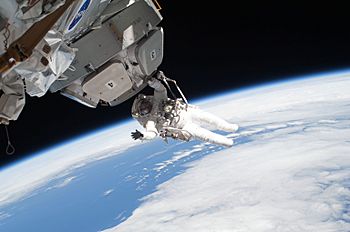
Patrick during EVA 3, preparing the Cupola for operational use following its installation on the ISS
|
|
| Mission type | ISS assembly |
|---|---|
| Operator | NASA |
| Mission duration | 13 days, 18 hours, 6 minutes, 24 seconds |
| Distance travelled | 9,250,000 kilometres (5,750,000 mi) |
| Orbits completed | 217 |
| Spacecraft properties | |
| Spacecraft | Space Shuttle Endeavour |
| Launch mass | 2,051,127 kilograms (4,521,961 lb) (total) 121,320 kilograms (267,470 lb) (orbiter) |
| Landing mass | 91,033 kilograms (200,694 lb) |
| Payload mass | 19,000 kilograms (42,000 lb) |
| Crew | |
| Crew size | 6 |
| Members |
|
| Start of mission | |
| Launch date | 8 February 2010, 09:14 UTC |
| Launch site | Kennedy LC-39A |
| End of mission | |
| Landing date | 22 February 2010, 03:22:10 UTC |
| Landing site | Kennedy SLF Runway 15 |
| Orbital parameters | |
| Reference system | Geocentric |
| Regime | Low Earth |
| Perigee | 341 kilometres (212 mi) |
| Apogee | 356 kilometres (221 mi) |
| Inclination | 51.6 degrees |
| Period | 92 minutes |
| Docking with ISS | |
| Docking port | PMA-2 (Harmony forward) |
| Docking date | 10 February 2010, 05:26 UTC |
| Undocking date | 20 February 2010, 00:54 UTC |
| Time docked | 9 days, 19 hours, 28 minutes |
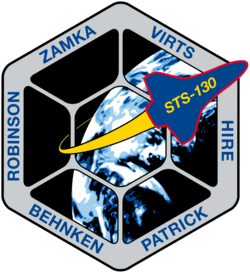 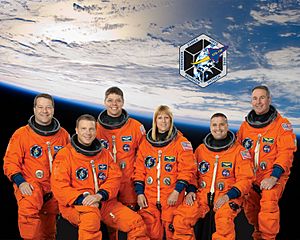 Seated (l–r) Virts and Zamka. Standing (l–r) are Patrick, Behnken, Hire and Robinson. |
|
STS-130 was a NASA Space Shuttle mission to the International Space Station (ISS). The Space Shuttle Endeavour carried two very important parts to the ISS: the Tranquility module and the Cupola. The Cupola is a special room with seven windows that gives astronauts a 360-degree view of space and Earth. Endeavour launched on February 8, 2010, and landed on February 21, 2010, after a successful mission.
Contents
- Meet the Astronauts: STS-130 Crew
- What Did STS-130 Carry to Space?
- Getting Ready for Launch: Shuttle Processing
- Important Moments of the Mission
- Mission Timeline: A Day-by-Day Journey
- Flight Day 1: Launch Day!
- Flight Day 2: Checking the Shuttle
- Flight Day 3: Arriving at the Space Station
- Flight Day 4: Getting Ready for Spacewalks
- Flight Day 5: First Spacewalk!
- Flight Day 6: Opening Tranquility
- Flight Day 7: Second Spacewalk!
- Flight Day 8: Moving the Cupola
- Flight Day 9: Moving PMA-3
- Flight Day 10: Final Spacewalk and Cupola Windows Open!
- Flight Day 11: A Call from the President
- Flight Day 12: Saying Goodbye to the ISS
- Flight Day 13: Undocking from the ISS
- Flight Day 14: Getting Ready to Land
- Flight Day 15: Landing Day!
- Spacewalks: Working Outside the Station
- Wake-Up Calls: Music in Space
- Images for kids
- See also
Meet the Astronauts: STS-130 Crew
The STS-130 mission had a crew of six brave astronauts. Each one had a special role to play in this important space journey.
- Commander: George D. Zamka (This was his second and last space flight.)
- Pilot: Terry W. Virts Jr. (This was his first time in space!)
- Mission Specialist 1: Kathryn P. Hire (Her second and last flight.)
- Mission Specialist 2: Stephen K. Robinson (His fourth and last flight.)
- Mission Specialist 3: Nicholas Patrick (His second and last flight.)
- Mission Specialist 4: Robert L. Behnken (His second flight.)
What Did STS-130 Carry to Space?
The main goal of STS-130 was to deliver two key parts to the International Space Station (ISS): the Tranquility module and the Cupola. These parts were carefully packed inside the Space Shuttle Endeavour.
- The Tranquility Module: This new section for the ISS is also known as Node 3. It was built in Italy and then flown to the Kennedy Space Center in Florida. Astronauts later named it Tranquility after a public poll. It provides more space for equipment and living quarters for the astronauts.
- The Cupola: This is a special observation deck with seven windows. It allows astronauts to have amazing views of Earth and space, and helps them control the station's robotic arm.
Getting Ready for Launch: Shuttle Processing
Before a Space Shuttle can launch, it goes through many steps to get ready. For STS-130, Endeavour was moved from its hangar to the Vehicle Assembly Building in December 2009.
Then, on January 6, 2010, Endeavour was slowly moved from the Vehicle Assembly Building to Launch Pad 39A. This journey of about 3.4 miles (5.5 km) took over six hours! Engineers had to work extra hard because of the unusually cold weather.
Launch Attempts: When Endeavour Lifted Off
The first try to launch was on February 7, 2010. However, bad weather with low clouds caused the launch to be delayed. The team had to wait.
The second launch attempt was a success! Endeavour blasted off at 4:14:08 AM EST (9:14:08 UTC) on February 8, 2010. It was an amazing sight!
Important Moments of the Mission
The STS-130 mission was a big deal for many reasons:
- It was the 161st time NASA sent a crew into space.
- It was the 130th Space Shuttle mission ever.
- It was the 24th flight for the Space Shuttle Endeavour.
- It was the 32nd time a Space Shuttle visited the International Space Station.
- It was the first Space Shuttle flight in 2010.
- It was the 34th time a Space Shuttle launched at night.
Mission Timeline: A Day-by-Day Journey
Flight Day 1: Launch Day!
Endeavour launched perfectly. Once in orbit, the crew opened the cargo bay doors and got ready for their work. Astronauts Nick Patrick and Kay Hire checked out the Shuttle Robotic Arm. The crew also sent back amazing pictures and videos of the external fuel tank.
-
Bolden, left, congratulates the launch team for a successful launch.
Flight Day 2: Checking the Shuttle
Most of this day was spent checking the shuttle's heat shield, called the thermal protection system (TPS). This is super important to make sure the shuttle is safe for re-entry into Earth's atmosphere. Astronauts Bob Behnken and Nick Patrick also got their spacesuits ready for the spacewalks.
Flight Day 3: Arriving at the Space Station
The crew guided Endeavour to catch up with the International Space Station (ISS). Commander George Zamka performed a special flip maneuver so the ISS crew could take photos of the shuttle's belly, checking the heat shield one last time. Endeavour then docked with the ISS. The hatches opened, and the two crews greeted each other. Astronauts began moving important equipment, including spacesuits, to the station.
Flight Day 4: Getting Ready for Spacewalks
Astronauts Nick Patrick and Bob Behnken spent the day getting all their tools ready for their first spacewalk. They also had to fix a small problem with one of Bob Behnken's spacesuits. To prepare for the spacewalk, Behnken and Patrick slept in the Quest Joint Airlock at a lower air pressure. This helps their bodies get used to the space environment and prevents them from getting sick during the spacewalk.
Flight Day 5: First Spacewalk!
The first spacewalk began early in the morning. Nick Patrick and Bob Behnken worked outside the shuttle. Their main job was to prepare the Tranquility module and Cupola for their move. The space station's robot arm then moved the Tranquility module to its new spot on the Unity node. The spacewalkers then connected important cables to bring Tranquility to life. They finished their spacewalk after six and a half hours.
Flight Day 6: Opening Tranquility
On this day, the astronauts opened the hatches to the new Tranquility module for the very first time! They started setting up the inside of the module. Terry Virts and Kay Hire also prepared the Cupola for its big move. Meanwhile, Bob Behnken and Nick Patrick got their tools ready for the second spacewalk.
Flight Day 7: Second Spacewalk!
The second spacewalk was completed by Bob Behnken and Nick Patrick. They worked for almost six hours. Their tasks included installing ammonia coolant loops, which are like the station's air conditioning system, and preparing the Cupola for its new home. A tiny bit of ammonia leaked during one connection, but the astronauts followed safety steps. The mission was also extended by one day, giving the crew more time to work.
Flight Day 8: Moving the Cupola
This was a big day! The Cupola was successfully moved from where it launched to its permanent spot on the Earth-facing side of Tranquility. Astronauts Kay Hire and Terry Virts used the station's robot arm to carefully move it. There was a small delay because some bolts were tighter than expected, but the team on Earth helped solve the problem. The crew continued setting up the Cupola, but its windows would stay closed until after the final spacewalk.
Flight Day 9: Moving PMA-3
On this day, another important part, the Pressurized Mating Adapter 3 (PMA-3), was moved to its permanent home on the end of Tranquility. This adapter helps protect the station from small space debris. Bob Behnken and Nick Patrick, with help from the ISS crew, moved it. Kay Hire and Terry Virts continued setting up the Cupola.
Flight Day 10: Final Spacewalk and Cupola Windows Open!
Astronauts Bob Behnken and Nick Patrick completed the third and final spacewalk of the mission. They connected more cables, removed covers from the Cupola, and installed handrails. After the spacewalk, pilot Terry Virts opened the windows on the Cupola for the very first time! This was an exciting moment, revealing incredible views of Earth.
Flight Day 11: A Call from the President
On this day, the astronauts received a special phone call from U.S. President Barack Obama and some school children. After the call, the crew began moving important life support equipment into the Tranquility module. Terry Virts continued working on setting up the Cupola for its robotic workstation. The spacewalkers also put their spacesuits and tools back into the shuttle for the trip home. The Space Shuttle also used its small engines to give the station a little boost, raising its orbit.
-
President Obama talking to the crew on flight day 11.
Flight Day 12: Saying Goodbye to the ISS
The STS-130 crew finished moving all their remaining items. They held a press conference and then, in a special ceremony, ISS commander Jeff Williams and shuttle commander George Zamka officially opened the Cupola for use. After a final meal together, the crews said their goodbyes and closed the hatches between the shuttle and the station. The STS-130 crew then prepared the shuttle for undocking.
Flight Day 13: Undocking from the ISS
Space Shuttle Endeavour successfully undocked from the ISS. After moving away, pilot Terry Virts flew Endeavour around the station, allowing the crew to take amazing pictures of the newly upgraded ISS. Once the fly-around was complete, the crew performed a final inspection of the shuttle's heat shield.
Flight Day 14: Getting Ready to Land
The crew of STS-130 spent the day getting Endeavour ready for its return to Earth. Commander George Zamka and pilot Terry Virts checked the flight control systems and tested the small steering engines. These checks are a normal part of preparing for landing and all went well. The rest of the crew packed up items that were no longer needed.
Flight Day 15: Landing Day!
On the final day, the crew woke up and began their last preparations for landing. This included closing the cargo bay doors and getting into their special launch and entry suits. Commander George Zamka and pilot Terry Virts fired Endeavour's main engines to slow the shuttle down, allowing it to begin its journey back through Earth's atmosphere.
-
Space Shuttle Endeavour touching down at the Shuttle Landing Facility at Kennedy Space Center, February 21, 2010.
Endeavour landed safely at the Kennedy Space Center's Shuttle Landing Facility. About two hours later, the crew exited the shuttle and inspected it. All six crew members then spoke to the press on the runway, sharing their excitement about the successful mission.
Spacewalks: Working Outside the Station
During the STS-130 mission, astronauts performed three spacewalks (also called EVAs, or Extra-Vehicular Activities). These were crucial for installing and setting up the new modules.
- EVA 1 (February 12, 2010): Robert L. Behnken and Nicholas Patrick worked for 6 hours and 32 minutes. They prepared the Unity node for Tranquility and released locks on the new module. They also connected important cables to bring Tranquility to life.
- EVA 2 (February 14, 2010): Robert L. Behnken and Nicholas Patrick worked for 5 hours and 54 minutes. They installed ammonia cooling lines for Tranquility and covered them with insulation. They also prepared the Cupola's future spot on Tranquility.
- EVA 3 (February 17, 2010): Nicholas Patrick and Robert L. Behnken worked for 5 hours and 48 minutes. They finished connecting the ammonia cooling lines, installed more cables and handrails on Tranquility, and removed the last covers from the Cupola.
Wake-Up Calls: Music in Space
NASA has a fun tradition of playing music to wake up astronauts in space. These songs are often chosen by their families and have a special meaning to the crew members.
- Day 2: "Give Me Your Eyes" by Brandon Heath for Terry Virts.
- Day 3: "Katmandu" by Bob Seger for George Zamka.
- Day 4: "Also sprach Zarathustra" by Richard Strauss for Nicholas Patrick.
- Day 5: "Beautiful Day" by U2 for Kathryn Hire.
- Day 6: "The Ballad of Serenity" by Sonny Rhodes for Robert Behnken.
- Day 7: "Too Much Stuff" by Delbert McClinton for Stephen Robinson.
- Day 8: "Forty Years On" by Edward Ernest Bowen & John Farmer for Nicholas Patrick.
- Day 9: "Parabola" by Tool for Robert Behnken.
- Day 10: "Window on the World" by Jimmy Buffett for Kathryn Hire.
- Day 11: "Oh Yeah" by Johnny A. for Stephen Robinson.
- Day 12: "I'm Gonna Be (500 Miles)" by Steven Curtis Chapman for Terry Virts.
- Day 13: "In Wonder" by Newsboys for Terry Virts.
- Day 14: "The Distance" by Cake for the entire crew.
- Day 15: "The Marines Hymn" by United States Marine Corps Band for George Zamka.
Images for kids
-
Bolden, left, congratulates Leinbach and the launch team in Firing Room Four of the Launch Control Center for a successful launch.
-
President Obama during a call to the crew on flight day 11.
-
Space Shuttle Endeavour touches down at the Shuttle Landing Facility at Kennedy Space Center, 21 February 2010.
See also
 In Spanish: STS-130 para niños
In Spanish: STS-130 para niños







